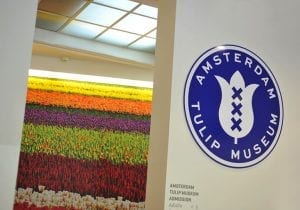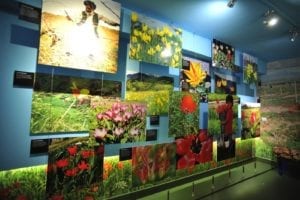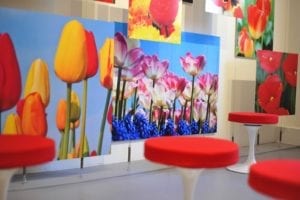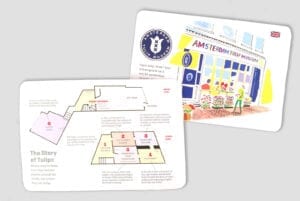Amsterdam Tulip Museum
Telling the story of the tulip The Amsterdam Tulip Museum asked for our help in improving their overall visitor experience.
The museum, a historic building in Amsterdam’s Jordaan district, is across the street from the Anne Frank House and contains a series of exhibit spaces along with a street-level gift shop.
As part of our work, we reconfigured the exhibit spaces, wrote and designed a narrative text panel system to help guide museum visitors, created a video viewing room, designed a new flexible gallery space that can be used for rotating exhibitions, and reimagined the gift shop.

View of the updated museum entrance, looking in on the gift shop. Our marching orders were to open up the gift store, make it more welcoming, and provide more opportunities for merchandising.
The existing store design was somewhat dark and cluttered, with a challenging circulation pattern — the opposite of what comes to mind when one thinks of tulips, springtime, and colorful fields of happiness. Tulips are about optimism, and that’s what we wanted the store to reflect.



Our shop redesign is bright, open, and airy, making it much easier to merchandise gifts and seasonal tulip bulbs.
Upon reopening, shop sales increased by over 45% from the previous year. Same products, same price points.
Yes, we believe in the power of design.

On to the museum itself: The multi-room permanent exhibit traces the historic journey of tulips from their origins in the Middle East, on to their spread to Constantinople, and from there up into Holland where they are distributed around the world.
We felt that while most of the exhibit did a very good job telling the story of the tulip, the experience could be designed to be more engaging and informative. Pictured is a new image gallery wall, providing an introduction to the experience.





The program was wide-ranging: We updated the museum’s logo, created transit advertising and shopping bags, and developed a series of multilingual “floor plan flashcards” that help visitors find their way within the museum.


Bonus runway shots: The museum’s updated “blue steel” logo found its way into the work of designer Junya Watanabe.
Designers
Alexander Isley
Christina Holland
Erika Back
Associate
Frank van der Horst
Writer
Alexander Isley
Collections
Special Collections Research Center
NC State University Libraries